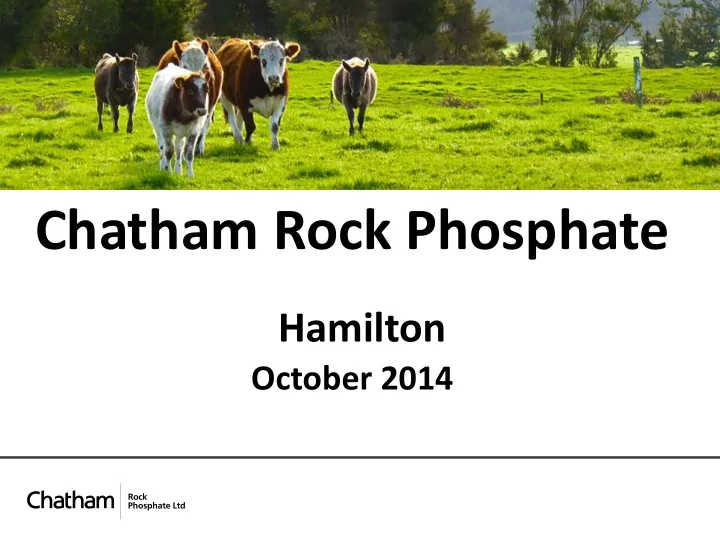

Chatham Rock Phosphate Hamilton October 2014
Overview Mining method Benefits to NZ Key effects and mitigation Sustainable management of NZ’s natural resources
Mining method Boskalis is the technology partner Existing technology with flexible connections
Benefits to NZ Only major NZ rock phosphate deposit Replace some of the 1m tonne imports – mostly from Morocco/Western Sahara $900m value to NZ – (NZIER) Import substitution & exports - $250m annually Environmental benefits of end product – low cadmium & direct application means less nutrient run-off to water New industry – undersea mining
Sediment plume The size and distribution of the sediment plume drives all effects beyond the mining site All experts agreed: Sediment model is appropriate and conservative The model takes into account an appropriate level of chalk If the amount of fine material doubled, the plume would be within the bounds of the original plots
Benthic communities and coral Unavoidable impact in mined areas But: • CRP will protect the most important areas • Area mined each year is small • CRP proposes environmental compensation
Coral Communities and Mining Plan coral communities (1700 m buffer) mining blocks no-mining areas 7
So what about BPAs? • Created by fishing industry for fishing industry, not equivalent to marine reserves • Set aside areas not actively bottom trawled • Prohibit bottom trawling only, not any other activity • Same or better biodiversity protection can be achieved
Chatham Rise ecosystem No reduction in primary productivity Key habitats within area protected through no-mining areas Size of affected area is small
Scale is important
Fishing Fishing experts agreed: o The marine consent area is not important area for commercial fish species or spawning o “Worst - case” fish stock modelling showed low to negligible effect on major fish stocks
Marine mammals Sound: • Mammals expected to move away • Exclusion zone prevents any physical effects Operational considerations: • Collision and entanglement unlikely to pose a risk • 30 years of observations indicates that area is not an important habitat for baleen whales (most sensitive group of marine mammals) 12
13
Seabirds No biological attractors to vessel Best practice lighting mitigation plan 14
Toxicology and radiology Experts agreed that : • Toxicology effects in water column will be very low • Radiological risk for marine life is negligible • No biomagnification of uranium or other metals in fish, but CRP will monitor it anyway • Uranium accumulation in soils has and will continue to occur from use of all phosphatic fertilisers; this is a long- term national issue 15
Balancing exercise • CRP’s project provides unique opportunity for NZ • Benefits are significant • Environmental risks are low or can be managed properly • Consistent with “sustainable management” 16
Thank you
Recommend
More recommend